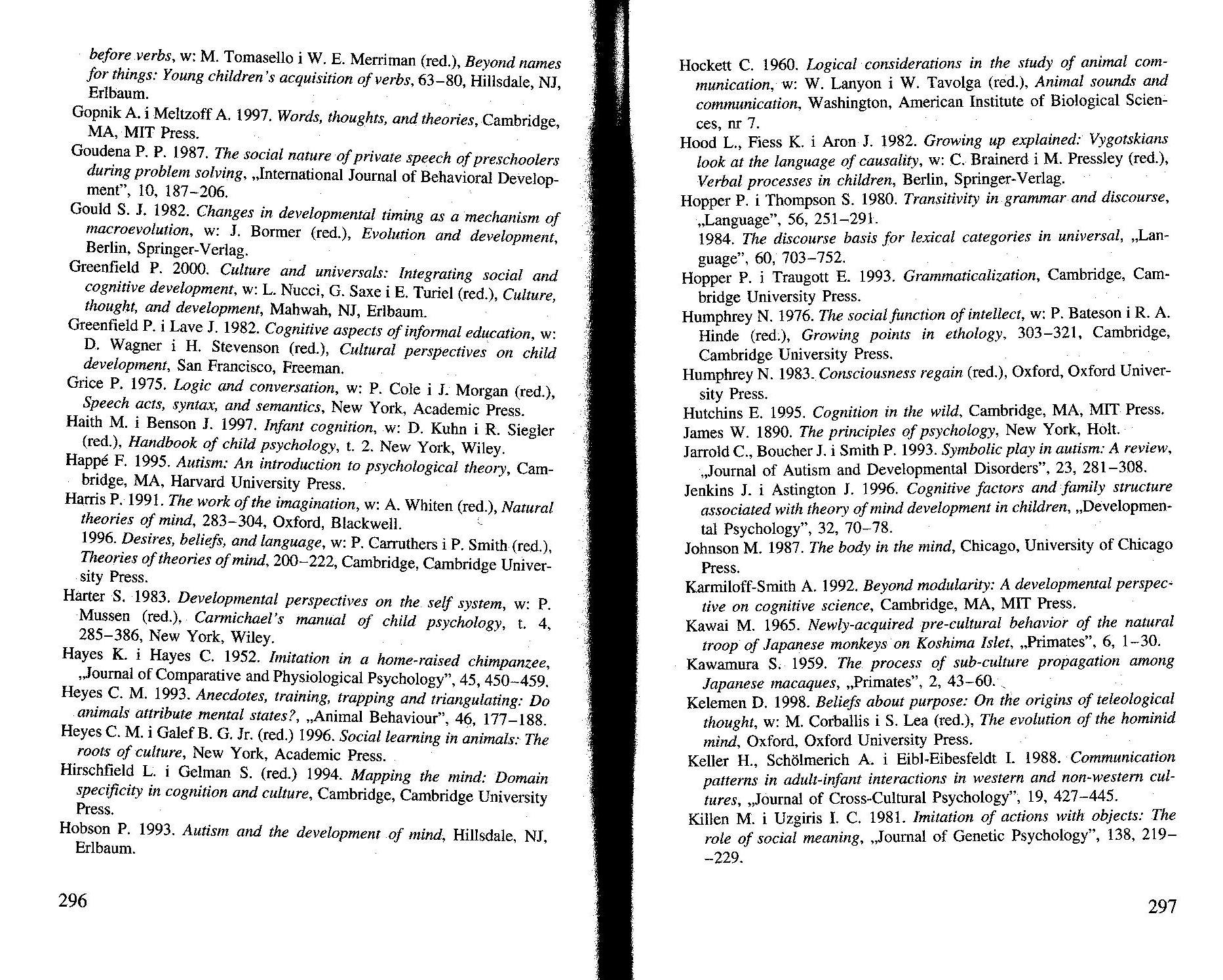CCF20090212�147

before verbs, w: M. Tomasello i W. E. Merriman (red.), Beyond names for things: Young childrens acquisition ofverbs, 63-80, Hillsdale, NJ, Erlbaum.
Gopnik A. i Meltzoff A. 1997. Words, thoughts, and theories, Cambridge, MA, MIT Press.
Goudena P. P. 1987. The social naturę of prwate speech of preschoolers during problem solving, „International Journal of Behavioral Develop-ment”, 10, 187-206.
Gould S. J. 1982. Changes in developmental timing as a mechanism of macroevolution, w: J. Bormer (red.), Evolution and development, Berlin, Springer-Verłag.
Greenfield P. 2000. Culture and universals: Integrating social and cognitive development, w: L. Nucci, G. Saxe i E. Turiel (red.), Culture, thought, and development, Mahwah, NJ, Erlbaum.
Greenfield P. i Lave J. 1982. Cognitive aspects ofinformal education, w: D. Wagner i H. Stevenson (red.), Cultural perspectives on child development, San Francisco, Freeman.
Grice P. 1975. Logic and conversation, w: P. Cole i J. Morgan (red.), Speech acts, syntax, and semantics, New York, Academic Press.
Haith M. i Benson J. 1997. Infant cognition, w: D. Kuhn i R. Siegler (red.), Handbook of child psychology, t. 2. New York, Wiley.
Happć F. 1995. Autism: An introduction to psychological theory, Cambridge, MA, Harvard University Press.
Harris P. 1991. The work ofthe imagination, w: A. Whiten (red.), Natural theories of mind, 283-304, Oxford, Blackwell.
1996. Desires, beliefs, and language, w: P. Carruthers i P. Smith (red.), Theories of theories ofmind, 200-222, Cambridge, Cambridge Univer-sity Press.
Harter S. 1983. Developmental perspectives on the self system, w: P. Mussen (red.), CarmichaeTs tnanual of child psychology, t. 4, 285-386, New York, Wiley.
Hayes K. i Hayes C. 1952. Imitation in a home-raised chimpanzee,
, Journal of Comparative and Physiologicał Psychology”, 45, 450-459.
Heyes C. M. 1993. Anecdotes, training, trapping and triangulating: Do animalś attribute mental States?, „Animal Behaviour”, 46, 177-188.
Heyes C. M. i Galef B. G. Jr. (red.) 1996. Social learning in animals: The roots of culture, New York, Academic Press.
Hirschfield L. i Gelman S. (red.) 1994. Mapping the mind: Domain specificity in cognition and culture, Cambridge, Cambridge University Press.
Hobson P. 1993. Autism and the development of mind, Hillsdale, NJ, Erlbaum.
Hockett C. 1960. Logical considerations in the study of animal Communications w: W. Lanyon i W. Tavolga (red.), Animal sounds and communication, Washington, American Institute of Biological Sciences, nr 7.
Hood L., Fiess K. i Aron J. 1982. Growing up explained: Vygotskians look at the language of causality, w: C. Brainerd i M. Pressley (red.), Verbal processes in children, Berlin, Springer-Verlag.
Hopper P. i Thompson S. 1980. Transitivity in grammar and discourse, „Language”, 56, 251-291.
1984. The discourse basis for lexical categories in universal, „Language”, 60, 703-752.
Hopper P. i Traugott E. 1993. Grammaticalization, Cambridge, Cambridge University Press.
Humphrey N. 1976. The social function ofintellect, w: P. Bateson i R. A. Hinde (red.), Growing points in ethology, 303-321, Cambridge, Cambridge University Press.
Humphrey N. 1983. Consciousness regain (red.), Oxford, Oxford Univer-sity Press.
Hutchins E. 1995. Cognition in the wilds Cambridge, MA, MIT Press.
James W. 1890. The principles of psychology, New York, Holt.
Jarrold C., Boucher J. i Smith P. 1993. Symbolic play in autism: A review, „Journal of Autism and Developmental Disorders”, 23, 281-308.
Jenkins J. i Astington J. 1996. Cognitive factors and family structure associated with theory ofmind development in children, „Developmen-tał Psychology”, 32, 70-78.
Johnson M. 1987. The body in the mind, Chicago, University of Chicago Press.
Karmiloff-Smith A. 1992. Beyond modularity: A developmental perspec-tive on cognitive science, Cambridge, MA, MIT Press.
Kawai M. 1965. Newly-acąuired pre-cultural behavior of the natural troop of Japanese monkeys on Koshima Islet, „Primates”, 6, 1-30.
Kawamura S. 1959. The process of sub-culture propagation among Japanese macaąues, „Primates”, 2, 43-60.
Kelemen D. 1998. Beliefs about purpose: On the origins of teleological thought, w: M. Corballis i S. Lea (md.), The evolution of the hominid mind, Oxford, Oxford University Press.
Keller H., Scholmerich A. i Eibl-Eibesfeldt I. 1988. Communication patterns in adult-infant interactions in western and non-westem cul-tures, „Journal of Cross-Cultural Psychology”, 19, 427-445.
Killen M. i Uzgiris I. C. 1981. Imitation of actions with objects: The role of social meaning, , Journal of Genetic Psychology”, 138, 219— -229.
297
Wyszukiwarka
Podobne podstrony:
IMAG0125 (3) Units View Bookswefpm Immediately before the transmission the red LED flashes rapidly a
CCF20090225�127 ó tym świadczy książka Cłlazera i Moynihańa Beyond the Melting Pot. Teza, którą prag
IMAG0127 (2) Units Vlew BooksOptlonimgam ShJplDS Every 50 seconds red LED illuminates for 2 seconds
3 Termiaology of Ritual Bread 67 Bulgarian names for cakes, similar to the loaves for the cerem
BHE0000W10012 SHOWS INSPECTION ORDER SHOWS ITEM NAMES FOR DETAILED PROCEDURES SHOW POINTS REOUIRING
CCF20091212�025 GRĄ
CCF20091212�029 GRANDPAS DAY Posłuchaj, a następnie zaśpiewaj piosenkę. Hooray for Grandpa .Hooray f
koliber z motylem i (3) V V • •••Symbol List The pair of colors whose names are listed below in r
S20C 409120813182 happy colo red marbies scarf continued Level f-asy Knitted Measurements Beforefeit
rose cottage welcome4 SYMBOL LIST The pairs of colors whose names arc listed below in red should be
Summary p306 306 CONYERSATIONAL PORTUGUESE 7. Verbs ending in -guer ot -guir In these verbs gu cha
CCF20090523�043 tif KARLR. POPPER (Próbnymi teoriami —PT, przyp. red.) Gatunek jest próbnym rozwiąza
4 (862) Symbol List The pairs of colors whose names are listed below in red should be combincd in th
ZDIĘCIA0081 V V Complete the rule in the Learn this! box with before, after or atthesametimeas. i 2
więcej podobnych podstron